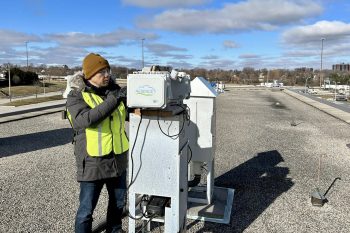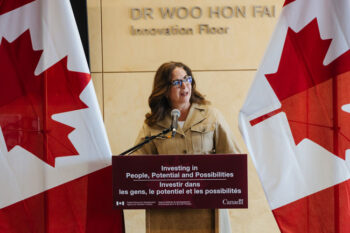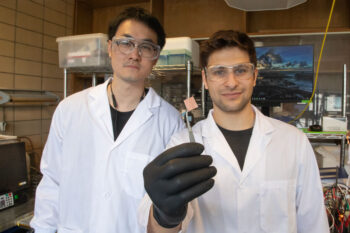U of T Engineering researchers have launched two major air quality studies to assess non-tailpipe emissions and winter air pollutants. The studies will involve collecting data at notable landmarks across the city of Toronto, including at the CN Tower, two U of T campuses, Toronto Pearson International Airport and High Park. The forthcoming findings could inform future work focused on understanding possible links between air pollutants and adverse health outcomes.
For the Improved Assessment and Characterization of Traffic Emissions (IMPACT) study, Professors Greg Evans (ChemE, ISTEP), Marianne Hatzopoulou (CivMin) and Arthur Chan (ChemE) will investigate variations in the concentrations of non-exhaust emissions — such as those arising from brake, tire and road wear — across Toronto.
“The good news is that vehicle technologies have improved to the point where tailpipe emissions from cars have dropped significantly. Unfortunately, at the same time, we’re seeing a steady increase in non-tailpipe emissions,” says Evans.
“More and more Canadian drivers are choosing to buy heavier vehicles, such as pickup trucks and SUVs, where more brake and tire wear is needed to slow them down. As brake pads and tires wear out, they shed lots of particles that end up in the water and in the air. It’s important to understand our exposure to these emissions.”
In a separate study running in parallel to the IMPACT project, Evans, Hatzopoulou and Chan will be contributing to the Study of Winter Air Pollution in Toronto (SWAPIT), led by Environment and Climate Change Canada, to explore air pollution in colder months.
Notably, the SWAPIT project is among only a few air quality studies to be completed in the winter and it is the largest wintertime urban air quality research ever undertaken globally, in terms of the number of pollutants measured.
“Most air quality research has been conducted during the summer, when smog and wildfires are most prevalent, but air pollution continues to be an issue in colder months,” says Evans. “And some pollutants are found in higher concentrations in the winter.”
Evans points out that some vehicle emission treatment systems are designed to function during warmer seasons, such as exhaust treatment for diesel-fuelled vehicles, which are much less effective at extracting nitrogen oxides when temperatures drop.
Additionally, stagnant winter air confounds the problem.
“On summer days, when we have higher winds, vehicle emissions are more quickly dispersed and diluted, and we don’t see them in such high concentrations as we move further from major roadways,” says Evans. “However, stagnant air is more common in winter, which causes pollutants to linger around those roads, creating higher concentrations that can persist for a kilometre or more away from the road.
“If we find that the pollutant levels and chemistry vary depending on the season, we have to consider what this means. It could, for example, raise questions about whether we need to push for better emission treatment systems or better ways to keep our windscreens frost-free without pulling in potentially polluted outside air. Of course, electrifying our vehicles over the coming decade will go a long way to addressing these issues.”

To get at answers to the questions posed by the IMPACT and SWAPIT projects, researchers have installed air quality measurement systems across Toronto, including on 40 roadside poles and atop the CN Tower. Heavily instrumented sites will also be set up at the U of T St. George and Scarborough campuses, High Park and Evergreen Brick Works. As well, the U of T Engineering team will use mobile labs — vehicles fitted with measurement systems — to collect samples as they navigate specific routes around the city.
Over a six-week period, spanning from late January into early March, the measurement systems will be collecting air samples at timed intervals. The team will be analyzing the samples for airborne particulate matter, including metals. With the AirSENCE monitoring technology created at U of T, researchers will also measure gases such as carbon monoxide, carbon dioxide, nitrogen oxides and ozone.
To better understand how pollutant concentrations might vary, U of T Engineering researchers will be setting up systems at varying distances from major roadways, including Highway 401. And the team will be taking advantage of the access to the CN Tower to install testing stations at varying heights to assess pollutant concentrations at different altitudes.
The findings from the IMPACT and SWAPIT projects will add to U of T Engineering’s comprehensive body of knowledge aimed at enhancing the understanding of urban air pollution and its impacts on human health and the environment.
Previously, researchers have evaluated air quality in the Toronto subway system, collected air quality data across the city with the UrbanScanner mobile lab and launched an initiative aimed at decarbonizing transportation, among other activities. And in recognition of their research contributions through the Southern Ontario Centre for Atmospheric Aerosol Research (SOCAAR), Evans, Hatzopoulou, Chan and their colleagues were awarded NSERC’s 2021 Blockhouse Prize for Interdisciplinary Research in Science and Engineering.
Evans hopes the IMPACT and SWAPIT initiatives will give researchers a clearer picture of air pollution in the city.
“Hopefully, what we learn will support future epidemiology to ask questions around health outcomes,” he says. “For instance, what are the health impacts in locations where the non-tailpipe emissions are higher? Is there an association between non-tailpipe emissions and various health impacts? What is the impact of stagnant air on our exposure to traffic pollutants?
“We can use the data we collect to form new questions and think about the bigger implications, particularly what health benefits we can expect over the coming decade as we reduce emissions from fossil fuel combustion.”



